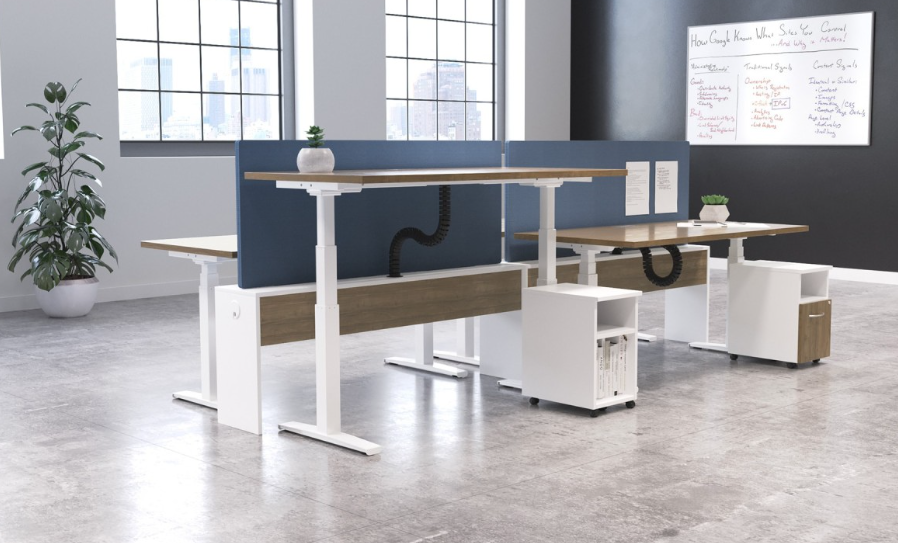Designing Ergonomic Workstations for Health and Productivity
Creating a workspace that supports long hours of concentration requires careful planning and attention to detail. In Phoenix, businesses that rely on modular workstations and professional office furniture installation can benefit from incorporating ergonomic design principles. A properly arranged workstation enhances productivity and lowers the risk of strain, fatigue, and injury over time.
The Role of Ergonomics in the Modern Office
Ergonomics is the study of how people interact with their environment, particularly in the workplace. In an office setting, it focuses on aligning furniture, technology, and accessories to support natural body positions. When employees spend hours at a desk, even minor misalignments can create discomfort. Over weeks and months, these small stresses may contribute to back pain, wrist problems, and eye strain. An ergonomic workstation provides an environment where posture, reach, and movement all complement human design.
Desk Height and Work Surface Arrangement
The desk serves as the anchor of any workstation. An ergonomic desk should allow the user to type or write with elbows bent at roughly ninety degrees, shoulders relaxed, and wrists straight. Adjustable desks, particularly sit-stand options, offer the ability to vary posture throughout the day. Work surface arrangement also plays a role. Frequently used items, such as a keyboard, mouse, or notepad, should remain within easy reach. Less common items may be placed further away to encourage occasional movement.
Chair Selection and Adjustment
A high-quality office chair makes a significant difference in comfort and long-term health. An ergonomic chair provides adjustable seat height, lumbar support, and armrests. The seat height should position feet flat on the floor with thighs parallel to the ground. The backrest should support the natural curve of the lower spine. Armrests, when properly adjusted, help reduce strain on shoulders and wrists. Encouraging employees to learn how to change their chairs to fit their bodies promotes consistency in ergonomic practices.
Monitor Placement and Visual Comfort
Workstation design frequently overlooks the computer monitor. Its height and distance are critical for reducing eye strain and neck discomfort. The top of the screen should rest at or slightly below eye level, and the screen should sit about an arm’s length away from the user. Glare from windows or overhead lighting can cause squinting and headaches, so monitor placement should minimize reflections. For employees who work extensively with dual monitors, aligning them evenly at the same height prevents awkward head movements.
See also: Balancing Savings and Style: Value Engineering in Commercial Build-Outs
Keyboard, Mouse, and Peripheral Devices
Improper positioning of input devices is a common cause of repetitive stress injuries. The keyboard should remain flat or slightly tilted away from the user to maintain neutral wrist alignment. The mouse should sit close to the keyboard, eliminating the need for extended reaching. Ergonomic accessories, such as split keyboards or vertical mice, can provide relief for individuals prone to wrist discomfort. For specialized tasks, additional peripherals like document holders or wrist rests help maintain a balanced setup.
Lighting and Environmental Considerations
Workstation design extends beyond furniture. Lighting plays a central role in visual comfort. Overhead fluorescent lights may cause glare or flickering, while poor lighting can lead to eye fatigue. Adjustable task lamps provide direct light for reading and paperwork. Noise control, temperature regulation, and air quality also influence employee well-being. A workstation that balances these environmental factors supports both focus and comfort.
Movement and Break Strategies
Even the most carefully arranged workstation cannot eliminate all strain. Regular movement remains necessary to maintain circulation and reduce stiffness. Encouraging employees to take short standing or walking breaks every hour helps prevent discomfort and fatigue. Incorporating stretch routines, alternating between sitting and standing, and scheduling brief pauses away from the screen are effective strategies for long-term health. A workstation should not lock the employee into one position but instead support varied postures throughout the day.
Training and Ongoing Evaluation
An ergonomic workstation is not a one-time project. It requires ongoing evaluation as job roles evolve and technology changes. Training sessions that teach employees how to adjust chairs, monitors, and accessories empower them to take ownership of their comfort. Periodic reviews by management or ergonomic specialists can identify developing issues and suggest improvements. This proactive approach ensures that workstation design remains aligned with health and productivity goals.
Businesses in Phoenix that invest in modular workstations and professional office furniture installation gain more than aesthetic appeal. They create an environment where ergonomics and design work together to protect employee health and foster efficiency. By following a thoughtful setup checklist that addresses desk height, seating, monitor placement, input devices, lighting, and movement, organizations reduce injury risks and enhance workplace satisfaction. For professional assistance in planning and installing ergonomic office solutions, visit Quality Installers.






